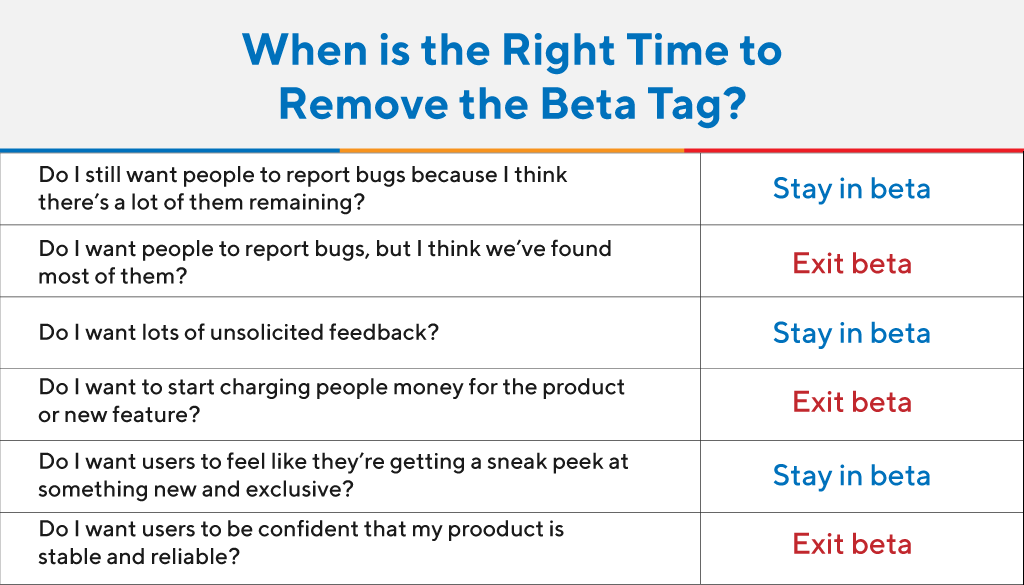Until real users get their hands on your product, you can never be 100% sure it works. That’s why product managers leverage beta testing. It’s such an incredibly important and useful tool in the product development process. Internal tests can’t replicate what happens in the real world. A well-run beta program will net a slew of bug reports, suggestions, and additional requests from beta testers.
The longer a beta program runs, the more input you’ll receive. While some nuggets of wisdom might continue to pop up, it’s generally a game of diminishing feedback returns.
So when should you pull the plug on your beta and officially toss your new version into the deep end? Is there any value to keeping the beta tag on even though things are ready for prime time?
The psychological weight of “beta” testing
Uncertainty isn’t popular in the workplace. At work we prefer a more transparent, more definitive picture at our jobs.
When a product or feature set lives in beta, the folks working on it are in limbo. In some ways, it’s the most customer-driven phase of product development because almost everything they’ll code and test is based on beta tester feedback.
While this isn’t a big deal for a limited period, the longer a beta goes, the more unstructured things can feel. Without a set date, teams can lose their strategic edge and just become firefighters. Both are valuable, but most teams prefer executing big-picture plans to tweaking UIs and squashing bugs.
In a SaaS world, every part of the product is eventually updated, so make sure your definition of done doesn’t create an interminable beta period.
A worthy roadmap milestone
Depending on your roadmap style and preferences, betas may or may not make an appearance. But they certainly play a role on the roadmap.
Indicating on your roadmap that a particular feature will go through a beta period communicates several essential points to stakeholders:
- It shows that a feature is exciting and significant enough to warrant a proper beta test
- It demonstrates when interested parties will be able to get their hands on the new feature in its beta state
- It also indicates that feedback that can shape the final product is actively sought out and appreciated
Of course, if you’re going to include a beta period on your roadmap, exiting beta and becoming “official” needs to be a roadmap milestone. Whether that’s a month or a year or ten years out, set that milestone on your roadmap. This gives everyone a hard target to wrap up the beta period and ship, plus it lets everyone know this feature won’t be in beta for some indeterminate length of time.
What’s the best-known product management beta-testing? Gmail
In the history of lengthy betas, none received quite as much attention as Google’s foray into the email market. Gmail launched in 2004, yet Google didn’t remove its beta tag until 2009. Why were five years required to switch the product to a finished state?
Google’s Larry Page has admitted that the beta tag was relatively arbitrary and was more about marketing than actual software development. In a SaaS environment, every product is receiving a steady stream of updates, so it’s not like there’s a precise moment in time when anything is “feature complete” and stays that way.
“The beta phase begins when a product propels from ‘functional but hideous’ to ‘polished and ready to go’” says Joel Lee of MakeUseOf. But with 100 million+ users, isn’t the beta tag a bit of a misnomer at that point? When you’re not charging people explicitly for the product or feature that’s still in beta, it doesn’t matter.
We’re guilty, but we feel OK about it
Here at ProductPlan, we’ve been known to occasionally add a beta tag on our new features now and then. Right now, it’s our “List Views” feature that’s currently flying the beta flag.
We released this feature as a beta because we knew it wasn’t entirely “done” yet. However, we also knew that getting real user usage and feedback was integral to making sure it is fantastic when it’s ready to go live without the beta tag. Plus, we didn’t want to deprive our users of getting access to this functionality, even if it wasn’t 100%.
Are we there yet?
So when is the right time to put that beta back in the closet and let your product or feature live its best life?
Here’s a quick reference guide to help you figure it out:
 To be sure your product doesn’t linger in beta limbo for too long, define precisely what criteria must be reached by your team o feel comfortable removing the beta tag. Make sure exiting beta is a milestone in your product roadmap, so everyone knows it’s an essential goal for the organization. This is one of the great features ProductPlan offers its users, so get started today adding those objectives.
To be sure your product doesn’t linger in beta limbo for too long, define precisely what criteria must be reached by your team o feel comfortable removing the beta tag. Make sure exiting beta is a milestone in your product roadmap, so everyone knows it’s an essential goal for the organization. This is one of the great features ProductPlan offers its users, so get started today adding those objectives.





